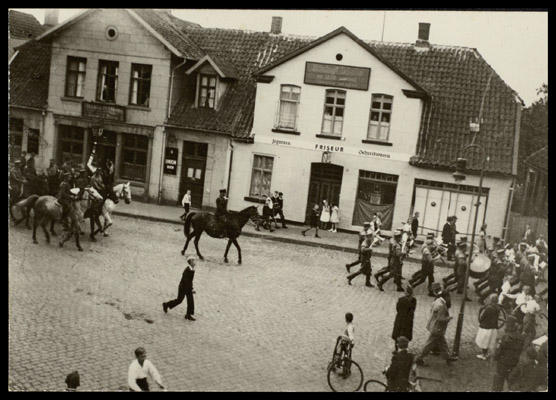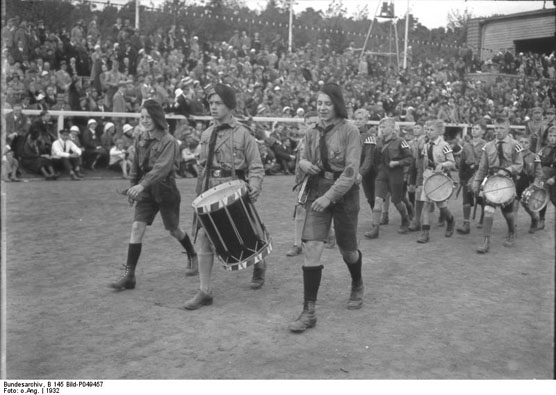Nazi propaganda
Propaganda is a tool of mass manipulation. National Socialists used it in order to shape people’s thoughts according to their ideology. In essence, propaganda simplifies complex ideas, works with constant repetition and appeals to people’s emotions.
How powerful do you think propaganda is in reality? And to what extent can propaganda explain the actions and choices of non-Jewish people in Nazi Germany?
© National Holocaust Centre and Museum
Harnessing mass media
A newly created Ministry of Propaganda under Joseph Goebbels centrally co-ordinated the themes of Nazi propaganda. Subsequently, his ministry spread these core messages through the mass media like the press, the radio or party rallies in order to influence public opinion.

Take a look at this party rally through the centre of Lingen, a small German town. What impression are the Storm Troopers trying to create? And how do ordinary people react on this day? Nazi propaganda generated mixed results depending on the popularity of the regime.
© National Holocaust Centre and Museum
Central themes of Nazi propaganda
The ‘Cult of the Leader’ is a dominant theme of Nazi propaganda. Adolf Hitler is portrayed as the nation’s saviour.

This portray of Hitler as the far-sighted leader, was created by his official photographer Heinrich Hoffmann. It is on the front page of a booklet that rewarded people who had made donations towards the National Socialist’s Welfare Organisation, the ‘Winterhilfswerk’. Public welfare won the Nazis many supporters.
© National Holocaust Centre and Museum
National Socialist propaganda celebrated the ‘People’s Community’. They promised to overcome class divisions in order to achieve the common good.
They also created fear around the idea of an enemy within. To this end, Nazis produced antisemitic propaganda.
Der Stürmer

This is the cover of Der Stürmer from January 1938. The headline demands capital punishment for so called “Racial defilement”. It refers to an important myth of Nazi propaganda: a supposedly “Jewish Galant” seducing an Aryan girl, thus polluting pure German blood. The title of the article reads: “Race defiler at work” and at the bottom of the page it says “The Jews are our misfortune”.
© National Holocaust Centre and Museum
Ruth David describes the effect that aggressive, sexualized antisemitic propaganda of the type published by Der Stürmer, had on her as a little girl. Der Stürmer was a tabloid format propaganda newspaper published by Julius Streicher.
© National Holocaust Centre and Museum
Hitler Youth
Nazi propaganda targeted in particular young people. To make National Socialism attractive, the Hitler Youth promoted comradeship and gave young people the pioneering role in creating a new, rejuvenated Germany.

Hitler Youth with drums marching in Potsdam 1932.
© Bundesarchiv, B 145 Bild-P049457 / CC-BY-SA 3.0
The Hitler Youth drum guaranteed maximum attention. Against the conventions of the time, the Hitler Youth gave young people the right to speak up loudly. Fascism was modern in the sense that it encouraged children and adolescents to cross the traditional limits of parental authority. This made fascism attractive to Youth independent of any propaganda slogans.
© National Holocaust Centre and Museum
Nazi propaganda succeeded because it resonated with existing ideas. The National Socialists offered new perspectives and reinforced their messaging with violence and terror.